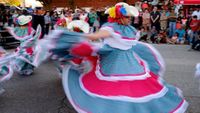Cinco de Mayo is celebrated annually on May 5, and in 2025, it falls on a Monday. This holiday commemorates a significant moment in Mexican history: the Mexican army's victory over the Second French Empire at the Battle of Puebla on May 5, 1862. While the day has evolved into a broader celebration of Mexican culture, particularly in the United States, its roots lie in a powerful narrative of resistance and resilience.
The Battle of Puebla was a remarkable event where an outnumbered band of Mexican soldiers faced 6,000 French troops at daybreak. Against the odds, Mexico emerged victorious by the evening, a triumph that President Benito Juárez declared as a national holiday. This victory not only boosted Mexican morale but also prevented the French from establishing a foothold that could have supported the Confederacy during the American Civil War. As noted by historians, if Napoleon III's forces had succeeded, it could have spelled doom for the Union's efforts to abolish slavery.
In the United States, Cinco de Mayo has transformed into a vibrant celebration of Mexican-American culture, particularly since the rise of the Chicano movement in the 1960s and 1970s. Mario García, a Chicanx historian from the University of California at Santa Barbara, emphasizes that while many view the day as merely a time for partying, it should also serve as a reminder of the deeper historical significance. "Everyone thinks that it's just party time, it's Corona time," García said in a May 2023 interview with USA TODAY. "We should go beyond that. We should have Cinco de Mayo events that go beyond partying and drinking, where we call attention to what the history is."
This holiday is often confused with Mexico's Independence Day, which is celebrated on September 16, known as the Día de la Independencia. The mix-up arises partly from the catchy name "Cinco de Mayo" compared to the more complex "Diez y seis de Septiembre." García points out that a lack of education about Chicanx history in American schools contributes to this misunderstanding. "When you study the history of Chicanos and Latinos, of course, they've been history makers," he explained, highlighting the significant contributions of Latinos, particularly during World War II, where almost half a million served, many earning congressional Medals of Honor.
In Texas, Cinco de Mayo holds particular importance as a way to honor the rich cultural heritage of Mexican-descent communities. Tejanos began holding fiestas patrias in the 1820s to reinforce their ties to Mexico and celebrate their unique bicultural identity. In cities like San Angelo and Houston, the celebrations have deep historical roots. San Angelo's festivities began with a grand parade in 1910, and by the late 1920s, the Mexican-American community organized events through the Comité Patriótico Mexicano. Estanislado Sedeno became a key figure in San Angelo’s Cinco de Mayo celebrations, holding the event for 27 years at Sedeno Plaza.
In Houston, early celebrations began in the 1920s, coinciding with a growing Hispanic population that warranted a Mexican consulate. Events included historic plays at Teatro Azteca, evolving over the years to encompass parades and dances. By the 1960s, organizations like the Hispanic Club Familias Unidas sponsored events such as the Baile Ranchero to celebrate Mexican culture through music and dance. Today, Cinco de Mayo in Houston remains a major event, with various civic organizations playing a crucial role in maintaining and expanding the celebrations.
As we raise our margarita glasses and dip into guacamole this Cinco de Mayo, it's also essential to reflect on the lessons this day teaches about freedom and democracy. According to a recent article, the victory at Puebla is not just a Mexican triumph but a shared moment of significance for the United States. The early Cinco de Mayo parties in the U.S. displayed flags of Mexico, the United States, Chile, and Peru, symbolizing a collective fight for liberty across the Americas.
As children learn about this history, they discover that their democracy is intertwined with the struggles of other nations. A children's author and historian remarked that students should understand the importance of the Mexican fight for freedom and how it influenced the United States. She emphasized that isolating the nation from its neighbors does not put America first; rather, it leaves it behind. The narrative of Cinco de Mayo serves as a reminder that the fight for freedom is a collective endeavor.
While Cinco de Mayo has become commercialized over the years, with companies offering "Cinco de Mayo" specials and cocktails, it is crucial to approach the celebration with cultural respect. Participants are encouraged to engage in events that authentically celebrate Mexican culture and to avoid trivializing the day with slogans like "Cinco de Drinko," which can undermine its significance.
In summary, Cinco de Mayo is a day that transcends mere festivity. It is a celebration of resilience, a reminder of shared struggles, and an opportunity to educate ourselves and others about the rich history that connects us all. As we enjoy the festivities this year, let’s also take a moment to appreciate the deeper meanings behind this cherished holiday.




